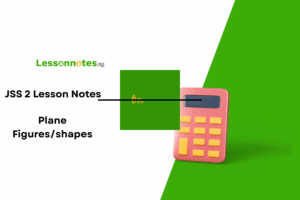Approximation JSS1 Mathematics Lesson Note
Download Lesson NoteTopic: Approximation
Introduction
Approximation is the process of using rounded numbers to estimate the outcome of calculations. Approximation can help us decide whether an answer to a calculation is right. We can approximate numbers by rounding them up to decimal places, significant figures, nearest whole numbers, tens, hundreds, etc.
Decimal Place/Point
A number such as 197.7658 is an example of a decimal number. The whole number part is 197, and the decimal part is 7658. The point between them is called a decimal point.
197.7658
Whole number. Decimal
Decimal point
To find the number of decimal places (d.p.), simply count the number of figures after the decimal point. Thus, the number above has 4 d.p.
197.7658
4th decimal place
3rd decimal place
2nd decimal place
1st decimal place
Guide to round-off numbers
To correct a number to a specific number of significant figures
- Look for the required significant figure
- Look at the next significant figure to the right (i.e. the decider)
- If the decider is 5 or more round up but if it is less than 5 add nothing
Example 1: Give the number 78.05624 correct to (a) 1 d.p., (b) 2 d.p., and (c) 3 d.p.
Solution:
78.1 (start counting from the number after the point). Note that zero is significant.
- 78.06 (after counting the number, check the next number; if the number is less than 5/<; it changes to zero but if it is 5 or >, it changes to 1 and adds to the next counted before it.)
- 78.056 (since the number is less, it turns to zero and it has no significance)
Example 2: Give 57.9945 correct to (a) 2dp (b) 4dp
Solution:
(a) 57.99 (2 d.p.)
(b) 57.9945 (4 d.p.)
Significant Figure
The word ‘significant’ means ‘important or non-zero digits,’ and it is another way of approximating numbers. We write significant figures as SF.
Numbers greater than zero
For example, the number 865 034 has six figures, or digits. The first figure from the left, i.e., 8, is worth 800 000 (place value), and it is the most significant figure. It is therefore the first significant figure, and 4 is the least or sixth significant figure. er
987654
1st s.f.
2nd s.f.
3rd s.f.
4th s.f.
5th s.f.
6th s.f.
Numbers less than zero
For example, 0.000007685 is given to 8 decimal places. The zero before the decimal number means there are no units, and the 5 zeros after the decimal point mean they are insignificant figures. Therefore, the most significant number or first significant is 7, followed by 6 and 8.
- 0 0 0 0 0 7 6 8
1sf 2sf 3sf
Note: the first significant figure is always the first non-zero figure as you read a number from the left
Guide to round-off numbers
To correct a number to a specific number of significant figure
- Look for the required significant figure
- Look at the next significant figure to the right (i.e. the decider)
- If the decider is 5 or more round up but if it is less than 5 add nothing
Example 3: Give 4540 correct to (a) 1 s.f (b) 2 s.f (c) 3 s.f
Solution:
Note the figures above, it helps just follow the figure correctly.
- a) 4540 = 5000 (the reason for getting 8000. After counting 7 the next number is 5 which will turn to 1 and add to the 7 counted and the other numbers turn to zeros).
- b) 4540 = 4500 (after counting 2 s.f the next number is 6 which turns to 1 and added to 5 to be 6 and the rest turn to zeros.
- c) 4540 = 4540 (after counting 3 s.f the next is 4 which turns to zero).
Example 2.4: Convert 0.00005791 to (a) 2 s.f (b) 3 s.f
Solution:
(a) 0.000058
(b) 0.0000579
Rounding Decimals to the Nearest, Tenth, Hundredth, and Thousandths and Whole.
Example 2.5: Give 474.4547 correct to the nearest
- Tenth
- Hundredth
- Thousandth
Solution:
Note that the counting starts after the point.
- 474.4547=474.5 (since the next number after counting is 5 or greater, it turns to 1 and add to the counted 4)
- 474.4547=474.45
- 474.4547=474.455
Example: Round off
- 13.73
- 34.245 to the nearest whole number.
Solution:
- 13.73=14(since the whole is 13, the next number is decimal which is 7, it will be turned to 1 and add to 13 to make it 14).
b. 34.245=34(since the next is l






















